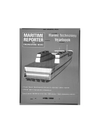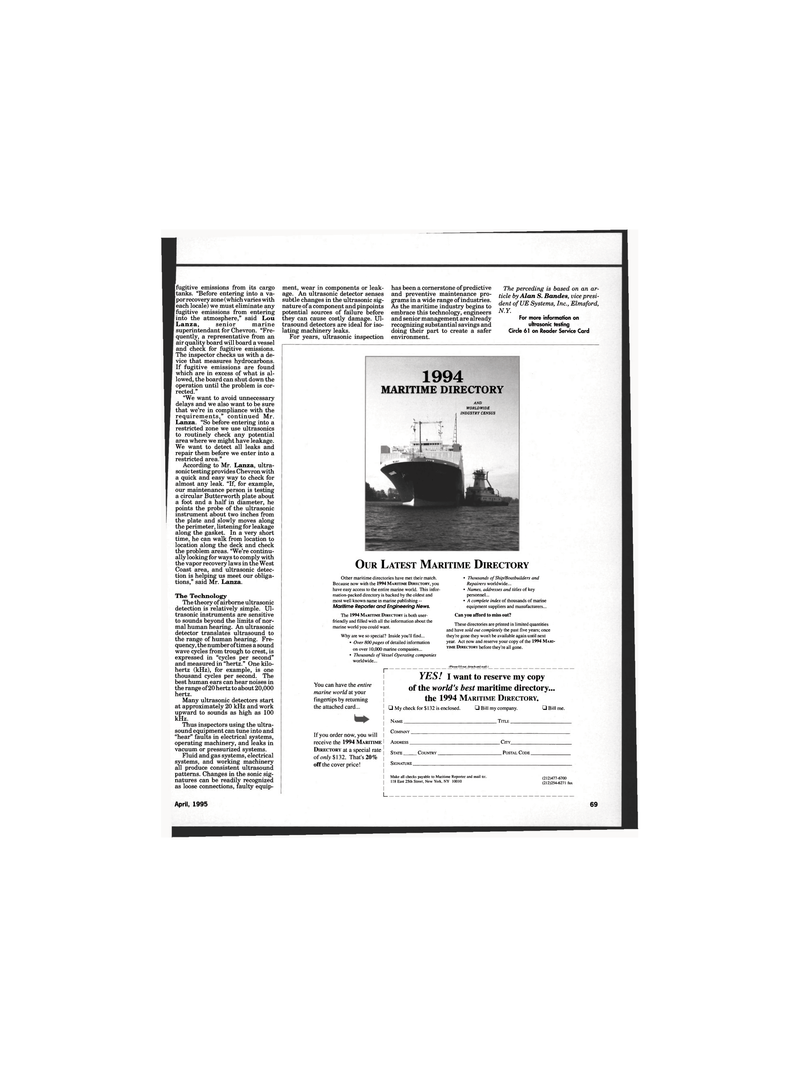
Page 59: of Maritime Reporter Magazine (April 1995)
Read this page in Pdf, Flash or Html5 edition of April 1995 Maritime Reporter Magazine
fugitive emissions from its cargo tanks. "Before entering into a va- por recovery zone (which varies with each locale) we must eliminate any fugitive emissions from entering into the atmosphere," said Lou
Lanza, senior marine superintendant for Chevron. "Fre- quently, a representative from an air quality board will board a vessel and check for fugitive emissions.
The inspector checks us with a de- vice that measures hydrocarbons.
If fugitive emissions are found which are in excess of what is al- lowed, the board can shut down the operation until the problem is cor- rected." "We want to avoid unnecessary delays and we also want to be sure that we're in compliance with the requirements," continued Mr.
Lanza. "So before entering into a restricted zone we use ultrasonics to routinely check any potential area where we might have leakage.
We want to detect all leaks and repair them before we enter into a restricted area."
According to Mr. Lanza, ultra- sonic testing provides Chevron with a quick and easy way to check for almost any leak. "If, for example, our maintenance person is testing a circular Butterworth plate about a foot and a half in diameter, he points the probe of the ultrasonic instrument about two inches from the plate and slowly moves along the perimeter, listening for leakage along the gasket. In a very short time, he can walk from location to location along the deck and check the problem areas. "We're continu- ally looking for ways to comply with the vapor recovery laws in the West
Coast area, and ultrasonic detec- tion is helping us meet our obliga- tions," said Mr. Lanza.
The Technology
The theory of airborne ultrasonic detection is relatively simple. Ul- trasonic instruments are sensitive to sounds beyond the limits of nor- mal human hearing. An ultrasonic detector translates ultrasound to the range of human hearing. Fre- quency, the number of times a sound wave cycles from trough to crest, is expressed in "cycles per second" and measured in "hertz." One kilo- hertz (kHz), for example, is one thousand cycles per second. The best human ears can hear noises in the range of 20 hertz to about 20,000 hertz.
Many ultrasonic detectors start at approximately 20 kHz and work upv/ard to sounds as high as 100 kHz.
Thus inspectors using the ultra- sound equipment can tune into and "hear" faults in electrical systems, operating machinery, and leaks in vacuum or pressurized systems.
Fluid and gas systems, electrical systems, and working machinery all produce consistent ultrasound patterns. Changes in the sonic sig- natures can be readily recognized as loose connections, faulty equip- ment, wear in components or leak- age. An ultrasonic detector senses subtle changes in the ultrasonic sig- nature of a component and pinpoints potential sources of failure before they can cause costly damage. Ul- trasound detectors are ideal for iso- lating machinery leaks.
For years, ultrasonic inspection has been a cornerstone of predictive and preventive maintenance pro- grams in a wide range of industries.
As the maritime industry begins to embrace this technology, engineers and senior management are already recognizing substantial savings and doing their part to create a safer environment.
The perceding is based on an ar- ticle by Alan S. Bandes, vice presi- dent of UE Systems, Inc., Elmsford,
N.Y.
For more information on ultrasonic testing
Circle 61 on Reader Service Card 1994
MARITIME DIRECTORY
AND
WORLDWIDE
INDUSTRY CENSUS
OUR LATEST MARITIME DIRECTORY
Other maritime directories have met their match.
Because now with the 1994 MARITIME DIRECTORY, you have easy access to the entire marine world. This infor- mation-packed directory is backed by the oldest and most well known name in marine publishing —
Maritime Reporter and Engineering News.
The 1994 MARITIME DIRECTORY is both user- friendly and filled with all the information about the marine world you could want.
Why are we so special? Inside you'll find... • Over 800 pages of detailed information on over 10,000 marine companies... • Thousands of Vessel Operating companies worldwide... r" • Thousands of Ship/Boatbuilders and
Repairers worldwide... • Names, addresses and titles of key personnel... • A complete index of thousands of marine equipment suppliers and manufacturers...
Can you afford to miss out?
These directories are printed in limited quantities and have sold out completely the past five years; once they're gone they won't be available again until next year. Act now and reserve your copy of the 1994 MARI-
TIME DIRECTORY before they're all gone. (Please fill out. detach and mail.I
You can have the entire marine world at your fingertips by returning the attached card...
If you order now, you will receive the 1994 MARITIME
DIRECTORY at a special rate of only $132. That's 20% off the cover price!
YES! I want to reserve my copy of the world's best maritime directory... the 1994 MARITIME DIRECTORY. • My check for $132 is enclosed.
NAME. • Bill my company.
TITLE • Bill me.
COMPANY
ADDRESS
STATE COUNTRY _
SIGNATURE _ CITY_
POSTAL CODE
Make all checks payable to Maritime Reporter and mail to:. 118 East 25th Street, New York, NY 10010 (212)477-6700 (212)254-6271 fax
L.
April, 1995 69

 58
58

 60
60
